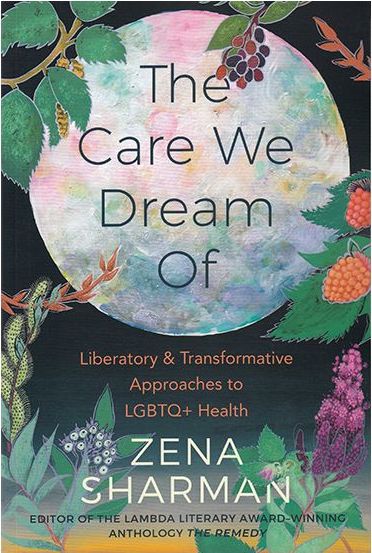
The following is an excerpt from The Care We Dream Of: Liberatory and Transformative Approaches to LGBTQ+ Health by Zena Sharman—a collection of essays, poetry, short fiction and interviews exploring the issues around queer and trans healthcare.
In this excerpt, Sharman interviews intersex activist, visual artist and public health researcher Sean Saifa Wall on the meaning of intersex justice. Up to 2 percent of the U.S. population is born intersex—or with a unique combination of what we perceive as male and female sex characteristics.
Zena Sharman: What does intersex justice mean to you?
Sean Saifa Wall: Intersex justice is an evolving ideology that looks at how intersex issues interact with different liberatory struggles. When I think about intersex justice, I think about the ways it intersects with Black liberation, trans liberation and reproductive justice. How does it tap into, speak to, and is informed by these other liberation movements?
For me, the heart and the crux of intersex justice is recognizing the harm that has befallen intersex individuals who are born with atypical bodies and have been harmed by the medical establishment. But it’s also about allowing people who are intersex to be in their bodies and to be free, whether or not they’ve been harmed. People have a right to live with dignity and be free from stigma and shame.
The idea of reparations is another critical component of intersex justice, in the form of apologies from institutions that have caused harm, recognizing the harm that has been done and making very specific amendments to address the harm. When I envision what the implementation of intersex justice would look like, I think about things like psychological support for parents and free medical care for people who have been harmed to have elective surgeries they choose.
The crux of intersex justice is recognizing the harm that has befallen intersex individuals who are born with atypical bodies and have been harmed by the medical establishment. But it’s also about allowing people who are intersex to be in their bodies and to be free.
Sharman: What does intersex justice look like in practice, both at the level of a whole system and at the level of relationships between patients and health care providers or within families?
Saifa: For me, the bare bones of intersex justice are a radical love and an acceptance of intersex people. When that love and acceptance present, people recognize that variations exist and not all bodies are the same, and everyone deserves to be treated with the same level of dignity and respect.
The implementation of intersex justice in a medical setting would be practitioners who listen and who recognize they have a patient who may have been harmed by the medical establishment. It’s patient-informed health care where medical providers understand each person has a body of wisdom inside of them and they should listen to that wisdom.
Intersex variations are often presented by medical providers as disorders, problems or abnormalities. We need to normalize those variations. Parents and families put so much trust in medical providers. What would it be like if doctors were to say, “Your baby has these differences. It’s not life-threatening. They will be okay.” And then the doctors work with the parents to create a treatment plan that really centers the child and doesn’t include surgery on that child, because surgery reinforces the idea that something is wrong, that there’s a pathology that needs to be addressed or fixed.
What would it look like if providers and parents had these conversations in a way that didn’t come from a place of pathology? There’s often this idea that parents of intersex children are vulnerable to being influenced by medical providers to consent to surgery on their child, and I think that’s partly true, but I also think bias exists because we’re all shaped by the gender binary.
Part of loving and accepting an intersex child in a context of intersex justice is parents willing to confront their internalized biases about gender and gender roles. The gender binary hurts everyone—intersex people, trans people, non-trans people. When I think long-term about what intersex justice could be, I imagine intersex people existing in an ecosystem, an orbit, a stratosphere of connections that really see them, affirm them on their path and push them along on their journey in a way that is not stigmatizing or pathologizing and that actually respects the whole of the individual.
Parents of intersex children are vulnerable to being influenced by medical providers to consent to surgery on their child … but I also think bias exists because we’re all shaped by the gender binary.
Sharman: Many intersex people have experienced medical violence and violation of their bodily autonomy, sovereignty, and consent when accessing health care. What would it look like to offer intersex folks care and healing in a way that really honors and loves their intersex bodies?
Saifa: I recently had a conversation with an intersex person in Bangladesh who experienced six surgeries when they were younger, some of which were exploratory so medical providers could see the inside of their anatomy. This person identifies as male and people ask them now, “Why don’t you have top surgery?” And at this point in their life, their response is, “I don’t want any more surgery!”
When we were talking, I asked them about their vision for Bangladeshi intersex folks. They told me they want a safe house for intersex people who don’t have family or support. That stayed with me. What does it mean to keep us safe? What does it mean for intersex people to feel safe in their bodies, in their homes and with medicine? How can we take those steps for intersex people to feel at home?
People talk a lot about the idea of being at home in your body. But when your house gets robbed, it feels like your home has been violated and desecrated by someone you don’t know. To feel safe in your home and neighborhood again, you have to go through a process of connecting with them. But some people can’t—some people move. For intersex people, I think the question is how can your body become home? How do you feel safe in your home again?
One of the liberatory models I use is somatic awareness. It’s not a perfect process and I don’t expect it to work for everyone, but it has helped me come back to my body in some ways. And there are still so many things I’m learning about my body. Black people, people of color, Indigenous folks, disabled folks, intersex folks—so many of us experience oppression in and on the body. One modality of liberation I’ve used is to see where oppression lives in my body and get it out, or address it, confront it or look at it.
I want people to feel at home in their bodies again and to have this deeply felt sense that they are normal and whole, despite what happened to them. I like the idea of collage because you take different elements and make something new. For intersex people who have been violated, what would it look like to take these pieces of yourself that have been desecrated and create something new?
Intersex surgeries exist in rape culture. There’s this idea that this thing is done to you and that’s it, you’re just left with the violation. Intersex justice says no, we get to reclaim what has been done to us and what has been taken away from us. Our narrative isn’t decided for us; we get to tell our own narrative and hold our perpetrators accountable.
Up next:





